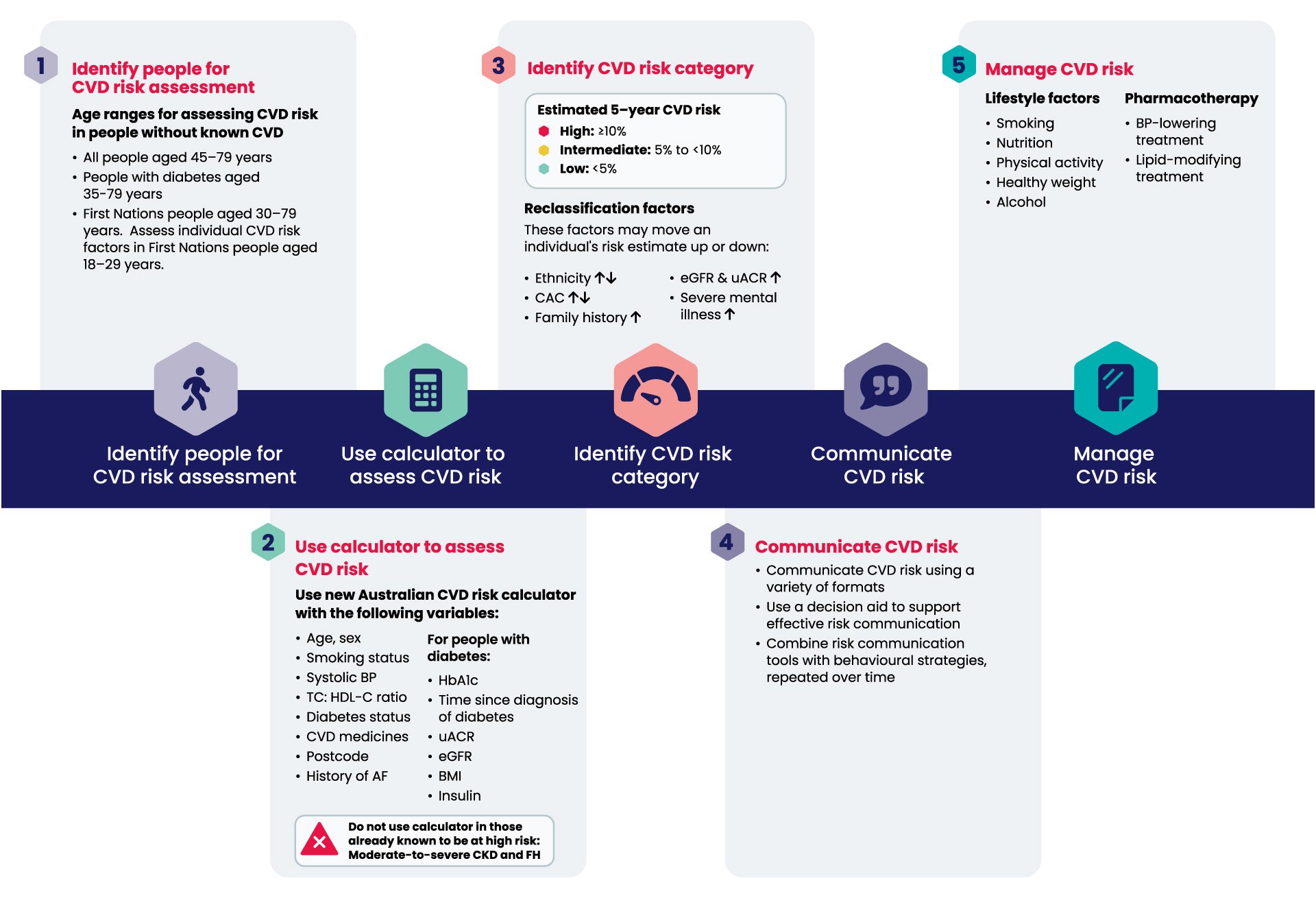
2023 Guideline for assessing and managing CVD risk and Australian CVD risk calculator
/
2023 Guideline for assessing and managing CVD risk and Australian CVD risk calculator
The guideline and calculator help healthcare professionals assess, communicate and manage a person’s risk of developing cardiovascular disease.
Cardiovascular disease (CVD) is responsible for significant morbidity and premature mortality in Australia. Ischaemic heart disease was the leading cause of death in 2020 and cerebrovascular disease was the third most common cause of death.
An individual’s risk of developing CVD depends on the combined effect of multiple risk factors. Risk assessment, therefore, remains fundamental to the early detection and prevention of CVD. The guideline encourages early modification of CVD risk factors, helps target medicines to those who will benefit most, and informs clinical decision-making.
As the first major update to Australian CVD risk assessment guidelines in over a decade, the 2023 Australian Guideline for assessing and managing cardiovascular disease risk and associated AUS CVD risk calculator reflect the latest evidence on assessing, communicating, and managing CVD risk. Developed using Australian-specific data and the latest evidence, it supersedes the 2012 Guidelines for the management of absolute cardiovascular disease risk.
What is the purpose of the guideline?
The guideline provides recommendations and practice advice for assessing, communicating, and managing CVD risk for the primary prevention of CVD in Australia.
The guideline includes:
recommendations for when and how to assess CVD risk
guidance and tools for using the new Aus CVD Risk Calculator
practical advice on how to apply the recommendations
tools to support communicating CVD risk
recommendations on how to manage CVD risk
a summary of the available evidence supporting the recommended approaches to risk assessment and management, together with the rationale for how available evidence has been interpreted for the Australian setting
specific recommendations, resources and practice points for assessing and managing CVD risk in First Nations people.
Who is the guideline for?
This guideline is intended for use by general practitioners, First Nations health workers and practitioners, nurses and nurse practitioners, allied health professionals, other primary care health professionals and physicians who support the primary prevention of CVD.
What's new in the guideline?
A new risk equation modified and recalibrated specifically for the Australian population to give a more accurate assessment of CVD risk. It is also the first Australian CVD risk calculator to account for socioeconomic disadvantage and diabetes specific risk factors.
A broader range of people without known CVD aged 45–79 years now recommended to have their risk assessed using the Aus CVD Risk Calculator.
New risk categories defined according to the new Aus CVD Risk Calculator:
High (≥10% risk over 5 years
Intermediate (5 to <10% risk over 5 years)
Low (<5% risk over 5 years)
New guidance provided on factors that may help clinicians refine and reclassify risk estimates when using the Aus CVD Risk Calculator; this is particularly relevant for people whose calculated risk is close to the threshold of another risk category.
New emphasis on communicating risk effectively to support shared decision-making between primary care clinicians and patients.
Specific recommendations, resources and practice advice for First Nations people embedded throughout the guideline.
Overview of process for CVD risk assessment and management

Aus CVD risk calculator
The new Australian cardiovascular disease risk calculator (Aus CVD Risk Calculator) is based on the NZ PREDICT-1° equation, which was developed from a large, contemporary New Zealand primary care cohort study. The equation has been recalibrated to the Australian population and modified for the Australian healthcare system for more accurate CVD risk assessment. It is the first Australian CVD risk calculator to account for socioeconomic disadvantage and diabetes specific risk factors.
How was the guideline developed?
The new guideline has been developed according to the processes and standards outlined in the 2016 National Health and Medical Research Council’s (NHMRC) Guidelines for Guidelines.
The guideline was developed under the direction and governance of a Guideline Advisory Group consisting of senior executives of ACDPA member organisations, an Expert Steering Group and seven advisory groups with multi-disciplinary, clinical and consumer input. Special attention was given to First Nations people’s health, and the Indigenous Health Expert Subgroup advised on every aspect of the guideline development.
Read more about how the guideline was developed here.
Endorsement

This guideline is endorsed by the Royal Australian College of General Practitioners (RACGP).
The Heart Foundation led the development of the new guideline and accompanying calculator on behalf of the Australian Chronic Disease Prevention Alliance (ACDPA) represented in this project by the Stroke Foundation, Diabetes Australia and Kidney Health Australia, with funding from the Commonwealth Department of Health and Aged Care.
You might also be interested in...
.png?width=550&height=auto&format=pjpg&auto=webp)
Acute coronary syndromes (ACS) clinical guideline
Access the guideline and discover what's new for your clinical practice.

Key statistics: Risk factors for cardiovascular disease
There are many different risk factors that increase your likelihood of developing a cardiovascular disease, such as heart disease.

Managing risk factors
For health professionals, includes lifestyle management, practical guide to pharmacological lipid management and more
Last updated14 April 2025
Last reviewed06 March 2024
